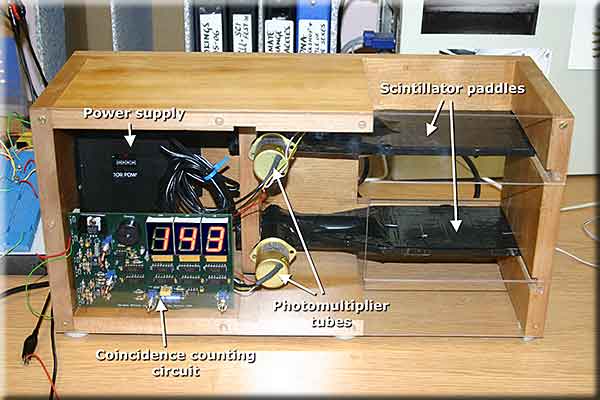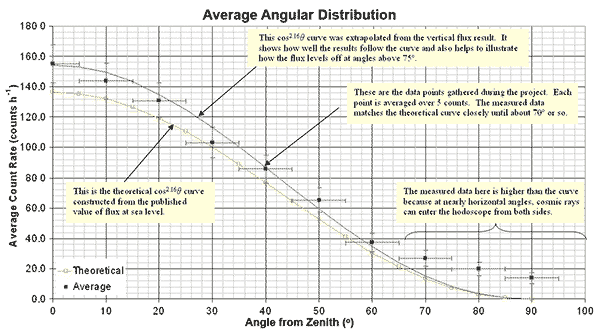|
PP4SS Exhibits
The Cosmic Ray Hodoscope |
||||||||||||||||||||||||||
 A picture of one of our four new cosmic ray detectors |
||||||||||||||||||||||||||
|
The first three exhibits have looked at "man-made" particles: that is, particles which are created by some experimental device (or, in the case of the accelerators, the consequences of the collisions of particles created in this way). The next three exhibits concentrate on those particles whose origins are the cosmic rays which permeate the galaxy.
The first of these is an experiment designed to detect the secondary products of cosmic ray particle collisions in the upper atmosphere, without attempting to identify their type. The cosmic ray hodoscope, shown above in its finished form, and based on designs obtained from the Berkeley Lab Cosmic Ray Telescope Project. How it works The operation of the device is straightforward. Two scintillator paddles (the flat, black plates above) are used to detect the flashes caused by the passage of a particle through the device. The scintillators generate faint flashes of light when the material from which they are made is ionised by a high-energy particle approaching an atom withn the paddle. These flashes are enhanced by photomultiplier tubes (the cylindrical objects attached to the plates, above), and the events are recorded by specialised circuitry. The passage of a cosmic ray (or one of the daughter particles created as a result of a collision in the atmosphere) is indicated when both paddles register an event within a short period of time. (Using two paddles allows us to separate out the inevitable thermal noise in the sensitive photomultipliers, in which stray electrons can occasionally cause spurious signals in one of the tubes. Only coincident events in both tubes are counted.) Although this version of the hodoscope cannot differentiate between the types of particle which cause the scintillations, it can be used to investigate the energy and distribution of the incoming particles: by rotating the device through each axis, we can make measurements of the rates of incident particles, and also the way in which cosmic rays vary with elevation, as described below. |
||||||||||||||||||||||||||
| Some results
Holly Batchelor, a fifth-year pupil from The Mary Erskine School in Edinburgh, spent six weeks with us in the summer of 2006, sponsored by the Nuffield Foundation. One of her tasks was to help put together the components for our four hodoscopes, and then to build one working unit. Having calibrated the detector, she made some preliminary measurements of angular distribution of cosmic rays, as well as working on the cloud chamber and the muon lifetime experiment. See the Nuffield Scholarship page [under construction], for more details. A preliminary graph (from Holly's Nuffield report) of the angular distribution of cosmic rays is shown below. (To see a larger, more readable version, click on the image below.) |
||||||||||||||||||||||||||
|
And, of course, placing a paddle on either side of someone's head lets us illustrate the fact the cosmic ray particles are penetrating us all the time.... This exhibit leads us naturally to the muon lifetime experiment. |
||||||||||||||||||||||||||
|








